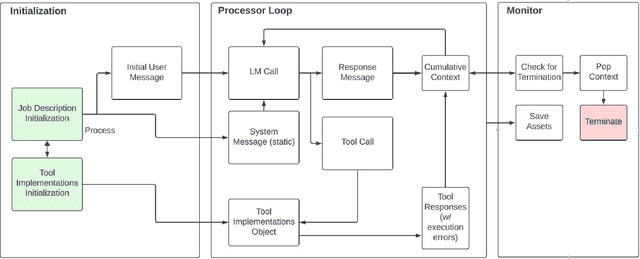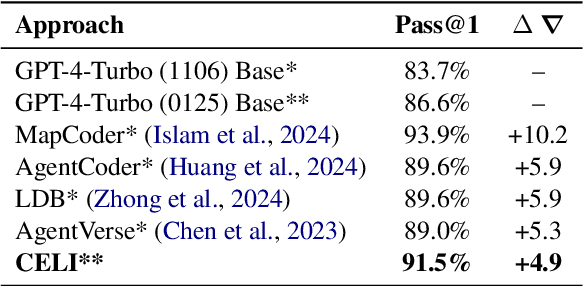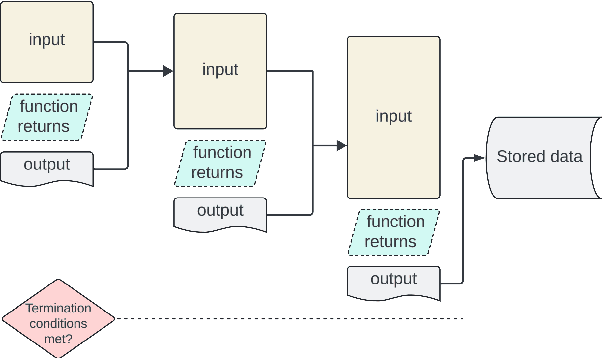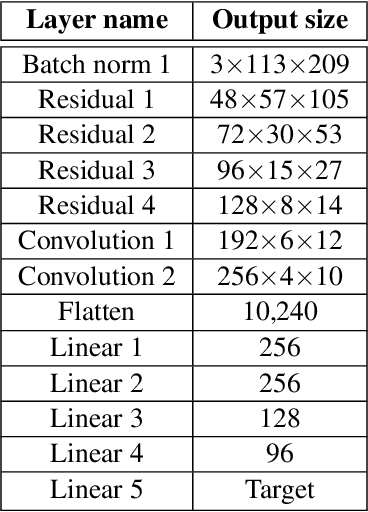Eric Yang
Sleepless Nights, Sugary Days: Creating Synthetic Users with Health Conditions for Realistic Coaching Agent Interactions
Feb 18, 2025Abstract:We present an end-to-end framework for generating synthetic users for evaluating interactive agents designed to encourage positive behavior changes, such as in health and lifestyle coaching. The synthetic users are grounded in health and lifestyle conditions, specifically sleep and diabetes management in this study, to ensure realistic interactions with the health coaching agent. Synthetic users are created in two stages: first, structured data are generated grounded in real-world health and lifestyle factors in addition to basic demographics and behavioral attributes; second, full profiles of the synthetic users are developed conditioned on the structured data. Interactions between synthetic users and the coaching agent are simulated using generative agent-based models such as Concordia, or directly by prompting a language model. Using two independently-developed agents for sleep and diabetes coaching as case studies, the validity of this framework is demonstrated by analyzing the coaching agent's understanding of the synthetic users' needs and challenges. Finally, through multiple blinded evaluations of user-coach interactions by human experts, we demonstrate that our synthetic users with health and behavioral attributes more accurately portray real human users with the same attributes, compared to generic synthetic users not grounded in such attributes. The proposed framework lays the foundation for efficient development of conversational agents through extensive, realistic, and grounded simulated interactions.
MPLite: Multi-Aspect Pretraining for Mining Clinical Health Records
Nov 17, 2024Abstract:The adoption of digital systems in healthcare has resulted in the accumulation of vast electronic health records (EHRs), offering valuable data for machine learning methods to predict patient health outcomes. However, single-visit records of patients are often neglected in the training process due to the lack of annotations of next-visit information, thereby limiting the predictive and expressive power of machine learning models. In this paper, we present a novel framework MPLite that utilizes Multi-aspect Pretraining with Lab results through a light-weight neural network to enhance medical concept representation and predict future health outcomes of individuals. By incorporating both structured medical data and additional information from lab results, our approach fully leverages patient admission records. We design a pretraining module that predicts medical codes based on lab results, ensuring robust prediction by fusing multiple aspects of features. Our experimental evaluation using both MIMIC-III and MIMIC-IV datasets demonstrates improvements over existing models in diagnosis prediction and heart failure prediction tasks, achieving a higher weighted-F1 and recall with MPLite. This work reveals the potential of integrating diverse aspects of data to advance predictive modeling in healthcare.
CELI: Controller-Embedded Language Model Interactions
Oct 18, 2024



Abstract:We introduce Controller-Embedded Language Model Interactions (CELI), a framework that integrates control logic directly within language model (LM) prompts, facilitating complex, multi-stage task execution. CELI addresses limitations of existing prompt engineering and workflow optimization techniques by embedding control logic directly within the operational context of language models, enabling dynamic adaptation to evolving task requirements. Our framework transfers control from the traditional programming execution environment to the LMs, allowing them to autonomously manage computational workflows while maintaining seamless interaction with external systems and functions. CELI supports arbitrary function calls with variable arguments, bridging the gap between LMs' adaptive reasoning capabilities and conventional software paradigms' structured control mechanisms. To evaluate CELI's versatility and effectiveness, we conducted case studies in two distinct domains: code generation (HumanEval benchmark) and multi-stage content generation (Wikipedia-style articles). The results demonstrate notable performance improvements across a range of domains. CELI achieved a 4.9 percentage point improvement over the best reported score of the baseline GPT-4 model on the HumanEval code generation benchmark. In multi-stage content generation, 94.4% of CELI-produced Wikipedia-style articles met or exceeded first draft quality when optimally configured, with 44.4% achieving high quality. These outcomes underscore CELI's potential for optimizing AI-driven workflows across diverse computational domains.
From Barriers to Tactics: A Behavioral Science-Informed Agentic Workflow for Personalized Nutrition Coaching
Oct 17, 2024Abstract:Effective management of cardiometabolic conditions requires sustained positive nutrition habits, often hindered by complex and individualized barriers. Direct human management is simply not scalable, while previous attempts aimed at automating nutrition coaching lack the personalization needed to address these diverse challenges. This paper introduces a novel LLM-powered agentic workflow designed to provide personalized nutrition coaching by directly targeting and mitigating patient-specific barriers. Grounded in behavioral science principles, the workflow leverages a comprehensive mapping of nutrition-related barriers to corresponding evidence-based strategies. A specialized LLM agent intentionally probes for and identifies the root cause of a patient's dietary struggles. Subsequently, a separate LLM agent delivers tailored tactics designed to overcome those specific barriers with patient context. We designed and validated our approach through a user study with individuals with cardiometabolic conditions, demonstrating the system's ability to accurately identify barriers and provide personalized guidance. Furthermore, we conducted a large-scale simulation study, grounding on real patient vignettes and expert-validated metrics, to evaluate the system's performance across a wide range of scenarios. Our findings demonstrate the potential of this LLM-powered agentic workflow to improve nutrition coaching by providing personalized, scalable, and behaviorally-informed interventions.
Context-Aware SQL Error Correction Using Few-Shot Learning -- A Novel Approach Based on NLQ, Error, and SQL Similarity
Oct 11, 2024Abstract:In recent years, the demand for automated SQL generation has increased significantly, driven by the need for efficient data querying in various applications. However, generating accurate SQL queries remains a challenge due to the complexity and variability of natural language inputs. This paper introduces a novel few-shot learning-based approach for error correction in SQL generation, enhancing the accuracy of generated queries by selecting the most suitable few-shot error correction examples for a given natural language question (NLQ). In our experiments with the open-source Gretel dataset, the proposed model offers a 39.2% increase in fixing errors from the baseline approach with no error correction and a 10% increase from a simple error correction method. The proposed technique leverages embedding-based similarity measures to identify the closest matches from a repository of few-shot examples. Each example comprises an incorrect SQL query, the resulting error, the correct SQL query, and detailed steps to transform the incorrect query into the correct one. By employing this method, the system can effectively guide the correction of errors in newly generated SQL queries. Our approach demonstrates significant improvements in SQL generation accuracy by providing contextually relevant examples that facilitate error identification and correction. The experimental results highlight the effectiveness of embedding-based selection in enhancing the few-shot learning process, leading to more precise and reliable SQL query generation. This research contributes to the field of automated SQL generation by offering a robust framework for error correction, paving the way for more advanced and user-friendly database interaction tools.
The Geometry of Queries: Query-Based Innovations in Retrieval-Augmented Generation
Jul 25, 2024Abstract:Digital health chatbots powered by Large Language Models (LLMs) have the potential to significantly improve personal health management for chronic conditions by providing accessible and on-demand health coaching and question-answering. However, these chatbots risk providing unverified and inaccurate information because LLMs generate responses based on patterns learned from diverse internet data. Retrieval Augmented Generation (RAG) can help mitigate hallucinations and inaccuracies in LLM responses by grounding it on reliable content. However, efficiently and accurately retrieving most relevant set of content for real-time user questions remains a challenge. In this work, we introduce Query-Based Retrieval Augmented Generation (QB-RAG), a novel approach that pre-computes a database of potential queries from a content base using LLMs. For an incoming patient question, QB-RAG efficiently matches it against this pre-generated query database using vector search, improving alignment between user questions and the content. We establish a theoretical foundation for QB-RAG and provide a comparative analysis of existing retrieval enhancement techniques for RAG systems. Finally, our empirical evaluation demonstrates that QB-RAG significantly improves the accuracy of healthcare question answering, paving the way for robust and trustworthy LLM applications in digital health.
Selective Fine-tuning on LLM-labeled Data May Reduce Reliance on Human Annotation: A Case Study Using Schedule-of-Event Table Detection
May 09, 2024



Abstract:Large Language Models (LLMs) have demonstrated their efficacy across a broad spectrum of tasks in healthcare applications. However, often LLMs need to be fine-tuned on task-specific expert annotated data to achieve optimal performance, which can be expensive and time consuming. In this study, we fine-tune PaLM-2 with parameter efficient fine-tuning (PEFT) using noisy labels obtained from gemini-pro 1.0 for the detection of Schedule-of-Event (SoE) tables, which specify care plan in clinical trial protocols. We introduce a filtering mechanism to select high-confidence labels for this table classification task, thereby reducing the noise in the auto-generated labels. We show that fine-tuned PaLM-2 with those labels achieves performance that exceeds the gemini-pro 1.0 and other LLMs. Furthermore, its performance is close to a PaLM-2 fine-tuned on labels obtained from non-expert annotators. Our results show that leveraging LLM-generated labels through powerful models like gemini-pro can potentially serve as a viable strategy for improving LLM performance through fine-tuning in specialized tasks, particularly in domains where expert annotations are scarce, expensive, or time-consuming to obtain.
Event Detection from Social Media for Epidemic Prediction
Apr 02, 2024Abstract:Social media is an easy-to-access platform providing timely updates about societal trends and events. Discussions regarding epidemic-related events such as infections, symptoms, and social interactions can be crucial for informing policymaking during epidemic outbreaks. In our work, we pioneer exploiting Event Detection (ED) for better preparedness and early warnings of any upcoming epidemic by developing a framework to extract and analyze epidemic-related events from social media posts. To this end, we curate an epidemic event ontology comprising seven disease-agnostic event types and construct a Twitter dataset SPEED with human-annotated events focused on the COVID-19 pandemic. Experimentation reveals how ED models trained on COVID-based SPEED can effectively detect epidemic events for three unseen epidemics of Monkeypox, Zika, and Dengue; while models trained on existing ED datasets fail miserably. Furthermore, we show that reporting sharp increases in the extracted events by our framework can provide warnings 4-9 weeks earlier than the WHO epidemic declaration for Monkeypox. This utility of our framework lays the foundations for better preparedness against emerging epidemics.
GloFlow: Global Image Alignment for Creation of Whole Slide Images for Pathology from Video
Nov 12, 2020

Abstract:The application of deep learning to pathology assumes the existence of digital whole slide images of pathology slides. However, slide digitization is bottlenecked by the high cost of precise motor stages in slide scanners that are needed for position information used for slide stitching. We propose GloFlow, a two-stage method for creating a whole slide image using optical flow-based image registration with global alignment using a computationally tractable graph-pruning approach. In the first stage, we train an optical flow predictor to predict pairwise translations between successive video frames to approximate a stitch. In the second stage, this approximate stitch is used to create a neighborhood graph to produce a corrected stitch. On a simulated dataset of video scans of WSIs, we find that our method outperforms known approaches to slide-stitching, and stitches WSIs resembling those produced by slide scanners.
The NVIDIA PilotNet Experiments
Oct 17, 2020



Abstract:Four years ago, an experimental system known as PilotNet became the first NVIDIA system to steer an autonomous car along a roadway. This system represents a departure from the classical approach for self-driving in which the process is manually decomposed into a series of modules, each performing a different task. In PilotNet, on the other hand, a single deep neural network (DNN) takes pixels as input and produces a desired vehicle trajectory as output; there are no distinct internal modules connected by human-designed interfaces. We believe that handcrafted interfaces ultimately limit performance by restricting information flow through the system and that a learned approach, in combination with other artificial intelligence systems that add redundancy, will lead to better overall performing systems. We continue to conduct research toward that goal. This document describes the PilotNet lane-keeping effort, carried out over the past five years by our NVIDIA PilotNet group in Holmdel, New Jersey. Here we present a snapshot of system status in mid-2020 and highlight some of the work done by the PilotNet group.
 Add to Chrome
Add to Chrome Add to Firefox
Add to Firefox Add to Edge
Add to Edge